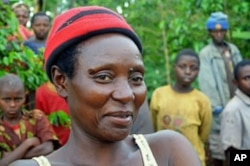Over the next three to four decades, temperatures in the Great Lakes Region of Central Africa are expected to rise about two degrees Celsius. Scientists say without immediate innovations in farming, crops will be devastated and the region will be thrown into chaos. So Rwanda is experimenting with what is already widely practiced in some neighboring countries. They are growing banana and coffee plants on the same soil to prepare for the new climate in the long term, and to grow the economy in the short term.
Frederick Musangwa has a farm in Rwanda. He grows bananas to eat, and coffee to sell. He cooks over a wood fire, and has no electricity or running water. In the past, he grew food crops to feed his family and sell in the market, and earned about $115 a year from coffee plants. More recently, he said, he has almost tripled his income from coffee.
Musangwa said he began harvesting more beans after he followed an agriculture expert's advice to plant the coffee directly under his banana trees. He says he is not worried about climate change - he is just trying to make a living.
Innovative farming techniques
But scientists say new agricultural techniques in this region like this one are not just about poverty alleviation - they are a critical component of preventing the region from destruction due to climate change. In one of the most densely populated parts of Africa, temperatures are going up, while the population continues to boom, and more and more erratic weather can be expected.
Sanginga Nteranya, the incoming director general of the International Institute of Tropical Agriculture, said that if farms systems are overhauled, people will not have to suffer.
“We have to be bold, actually. The consequences are difficult to contemplate because the population growth in this Great Lakes is the highest in Africa. It’s about 500 people per square kilometer and most of the wars that have been happening here is just about that,” said Nteranya.
Efficient land use
In countries like Tanzania and Uganda, farmers already are planting coffee bushes and banana trees on the same land, a technique called “intercropping.” Farmers say the bark from the banana trees serves as fertilizer for the coffee, a cash crop. The leaves shade the coffee from the bright sun, and the bananas feed their families while they wait for the coffee to harvest.
Laurence Jassogne, an agricultural systems scientist with the Consortium for Improving Agriculture-based Livelihoods in Central Africa, said growing coffee and bananas also can - in a small way - help attempts to stave off climate change by reducing carbon emissions.
“We are doing research at that moment that shows - the more shade you put - I know we are talking about bananas, but we are also talking about shade trees - then you also sequester carbon much more - and that’s good for carbon mitigation,” said Jassogne.
Food security concerns
Some officials are not yet convinced and want more research done before Rwandan farmers adopt intercropping as a widespread technique. They say coffee - one of the country’s largest foreign currency earners - is too important to the Rwandan economy to risk it being farmed haphazardly and mixed with other crops.
Burundi also has been reticent to abandon the single-crop policy in favor of banana-coffee farms. Jassonge said the concern is over food security, and farmers may take intercropping as a cue to overrun their coffee fields with food crops.
But the technique is not gaining quick acceptance here. Even though farmers like Musangwa are making more money from intercropping, other are more cautious. Marie Claudine Yansoneye grows beans, corn and potatoes - just enough to feed her family in the same neighborhood as Musangwa.
She said it makes sense that people grow crops together, because there is hardly any land. But given a choice, Marie Claudine said, she will always separate her coffee and bananas.

